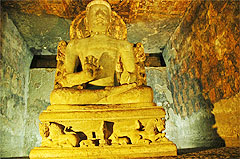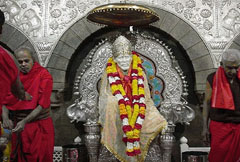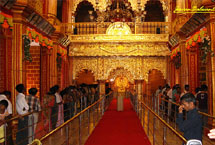Day 01-04; Mumabai
On arrival you will be met by our representative & transferred to
hotel, where we will be holding the rooms on ready occupancy basis.
After traditional welcome check in into hotel.
Overnight stay at Hotel.
Day 05-06 : Mumabai
Enjoy a full day sightseeing of the city of the dreams. Start your day
from the Gateway of India -one of Mumbai's most famous monuments
designed by George Wittett in the Indo-Saracenic style with Gujarati
and Islamic elements; watch the devotees pay their respects at the
Mahalaxmi temple, Sidhi Vinayak Temple , Jain temple and at the tomb
of the Muslim saint Haji Ali; see the magic of Indian history and
heritage explode at the Prince of Wales Museum; take a undersea walk
at the Taraporewala Aquarium and see the magic of the marine life
unfold before your eyes. Learn about the Zoroastrian burial rites at
the Tower of Silence and see the Christians celebrate their faith at
the innumerable churches and cathedrals across the city; important
ones being Mount St Mary's, Aloysius Church, Mahim Church and St
Thomas' Cathedral.
Overnight stay at Hotel.
Day 07-10: Mumbai/Aurangabad
In the morning, after breakfast we drive to Aurangabad. After checking
in the hotel, we visit the Daulatabad Fort - an old Hindu Fort that
later became the capital of the Delhi Sultanate and also of many
successive dynasties in the Deccan. Important monuments within the
fort include the Jami Masjid - now the Bharat Mata Mandir, the Chand
Minar, Elephant Tank and Chini Mahal or Chinese Palace; the 18th
century Ghrishneshwar Temple- made of spotted red sandstone,
decorative friezes and sculpture depict a pantheon of Indian gods
including Bhrama, Vishnu, Ganesh, the marriage of Shiva and Parvati,
celestial beings, and even Maratha heroes. The temple is an important
pilgrimage site for the savities as enshrines a jyotirlinga. We then
go on to visit the tomb of Aurangzeb- the last great Mogul, in the
village of Khuldabad. His simple tomb remains an eloquent testament to
his staunch faith and Spartan lifestyle. As per his instructions, the
tomb was built only with the few rupees he had earned by stitching
cloth caps! On his tombstone is inscribed in elegant Persian
calligraphy: "No marble sheets should shield me from the sky as I lie
there one with the earth." However the most noteworthy is the
Bibi-Ka-Maqbara, built by Aurangzeb as a mausoleum to his wife
Rabia-ud-Durrani. Similar in style to the Taj Mahal, it is also known
as the "Mini Taj" and "The Taj of the Deccan". Though not as opulent
and majestic as the Taj, the Maqbara is nonetheless a living testimony
of another king's love for his wife. The Maqbara stands in the middle
of a spacious and formally planned Mughal garden with axial ponds,
fountains, water channels, broad pathways and pavilions. and evening
back to Hotel.
Overnight stay at Hotel.
Day 11-12; Ajanta Caves
In the morning we leave for an excursion to Ajanta caves. The Buddhist
caves of Ajanta predating those of Ellora are a world heritage
site.Dating from the 2nd and 1st centuries B.C, the paintings and
sculptures of Ajanta considered masterpiece of Buddhist religious art,
have had a considerable artistic influence. The themes are intensely
religious in tone and centre round the Buddha, Bodhisattvas and
incidents from the life of Buddha and the Jatakas. The paintings are
executed on a ground of mud-plaster in the tempera technique.
Return back to hotel for overnight stay.
Day13; Ellora
In the morning we leave for Ellora. Whereas Ajanta Caves are noted for
their paintings, here it's the sculpture at Ellora that is remarkable.
It's thought that the builders of Ajanta moved to here when they
suddenly ceased construction at their earlier site. At Ellora, there
are a total of 34 caves, of which 12 are Buddhist, 17 Hindu and 5
Jain. Dating from A.D. 600 to 1000, the Ellora representations as
opposed to that of Ajanta, are more earthly, drawing their elements
from the Vajrayana school of Buddhism.
However, Ellora is more renowned for its exquisite architecture,
especially the Kailasa Temple, which is a remarkable example of
rock-cut temples in India on account of its striking proportion;
elaborate workmanship architectural content and sculptural
ornamentation. In the evening we leave for Shirdi (125 Kms/3 hrs).
Overnight stay at Hotel.
Day 14-16; Shirdi Sai Baba
Early morning, we visit the Mahasamadhi temple of Sri Sai Baba. Built
of white marble stones, the temple houses a life size statue of the
Baba which was sculpted by the Late Balaji Vasant in 1954 out of
Italian marble. The railings around it are full of ornamental
decorations.The temple has an assembly hall for about 600 devotees.
The assembly hall also houses a showcase having various items used by
the sage. The first floor of the temple has the pictures depicting the
life of the saint. Situated on the right side of the entrance of the
Samadhi Mandir is the Dwarkamai Mosque, where the Baba meditated and
stayed until the end of his life.
Main attraction of the site is the oil paintings of the sage. Near the
mosque, in a corridor is the dhuni or eternal flame that burns day and
night. Other places of importance are the Gurusthan, the Chavadi,the
Lendi Baug, the cottage of Abdul Baba, an ardent devotee of Shri Sai
Baba, the Kandoba Temple, Shani Mandir, Narsimha Mandir, Changdev
Maharaj Samadhi and the Sakori.
Overnight stay at Hotel.
Day 17: Shirdi- Mumbai
After breakfast we drive back to Mumbai |
|


 Have a query about your booking?
Have a query about your booking?





